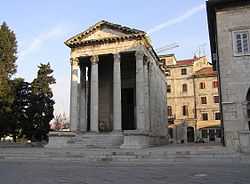Temple of Augustus (Pula)
| Temple of Augustus | |
|---|---|
 | |
 | |
| Coordinates | 44°52′13″N 13°50′30.5″E / 44.87028°N 13.841806°E |
| Location | Pula, Croatia |
| Type | Roman temple |
| Beginning date | circa 2 BC |
| Completion date | circa 14 AD |
| Dedicated to | Augustus |

The Temple of Augustus (Croatian: Augustov hram) is a well-preserved Roman temple in the city of Pula, Croatia (known in Roman times as Pola). Dedicated to the first Roman emperor, Augustus, it was probably built during the emperor's lifetime at some point between 2 BC and his death in AD 14.[1] It was built on a podium with a tetrastyle prostyle porch of Corinthian columns and measures about 8 m (26 ft) by 17.3 m (57 ft). The richly decorated frieze is similar to that of a somewhat larger and older temple, the Maison Carrée in Nîmes, France.[2]
History
The temple was part of a triad consisting of three temples. The Temple of Augustus stood at the left side of the central temple, and the similar temple of the goddess Diana stood on the other side of the main temple. Although the larger central temple has not survived, the whole back side of the Temple of Diana is still clearly visible due to its incorporation into the Communal Palace, built in 1296.
Under Byzantine rule, the temple was converted into a church, accounting for its survival to modern times, and was later used as a granary. It was struck by a bomb during an Allied air raid in 1944, almost totally destroying it, but was reconstructed in 1947. It is today used as a lapidarium to display items of Roman sculpture.[3][4]
Dedication
The temple's dedication originally consisted of bronze letters attached to the portico. Only the attachment holes now remain and much of the text has been destroyed over time. However, it consisted of a standard dedication also found on other Augustan temples, which read:
- ROMAE · ET · AUGUSTO · CAESARI · DIVI · F · PATRI · PATRIAE
- Roma and Augustus Caesar, son of the deity, father of the fatherland
This indicates that the temple was originally also co-dedicated to the goddess Roma, the personification of the city of Rome.[5] Unlike later temples, such as the Temple of Divus Augustus in Rome, the temple was not dedicated to divus (the deified) Augustus - a title only given to the emperor after his death. This, and the temple's architectural style, have allowed archaeologists to date the temple to the late Augustan period, prior to Augustus' death in AD 14.[6]
See also
References
- ↑ Radovan Radovinovic (ed.), The Croatian Adriatic, pp. 48-49. Naklada Naprijed, 1999. ISBN 953-178-097-8
- ↑ Donald S. Robertson, Greek and Roman Architecture, p. 214. Cambridge University Press, 1969. ISBN 0-521-09452-6
- ↑ Jane Foster, Footprint Croatia, p. 106. Footprint Travel Guides, 2004. ISBN 1-903471-79-6
- ↑ Jeanne Oliver, Croatia. Lonely Planet, 2005. ISBN 1-74059-487-8
- ↑ Duncan Fishwick, The Imperial Cult in the Latin West, p. 437. BRILL, 1990. ISBN 90-04-07105-9
- ↑ Ittai Gradel, Emperor Worship and Roman Religion, pp. 92-93. Oxford Classical Monographs, Clarendon Press, 2002. ISBN 0-19-815275-2
External links
![]() Media related to Temple of Roma and Augustus (Pula) at Wikimedia Commons
Media related to Temple of Roma and Augustus (Pula) at Wikimedia Commons